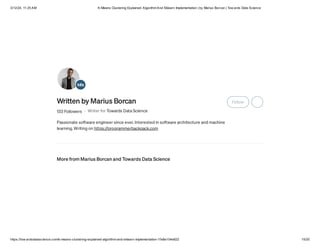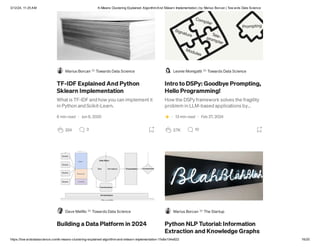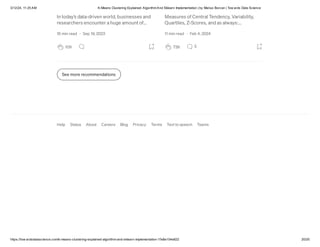The document provides a comprehensive overview of k-means clustering, a popular clustering algorithm in data science, including its purpose, applications, and implementation using the scikit-learn Python library. It explains the process of clustering, the importance of identifying patterns in data, and outlines the steps involved in the k-means algorithm. Additionally, the article includes practical coding examples for implementing k-means clustering on datasets, emphasizing its effectiveness in customer segmentation and information extraction.
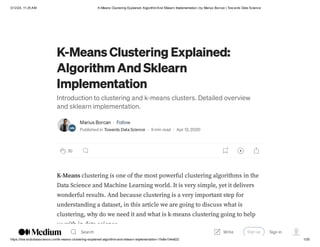

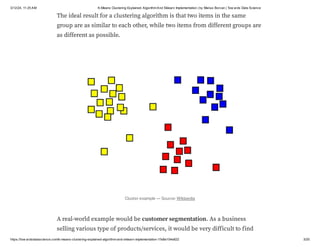
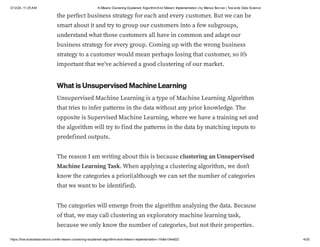
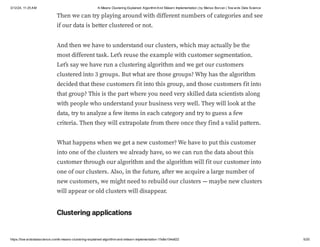
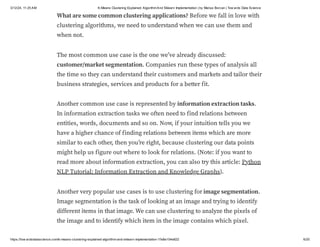
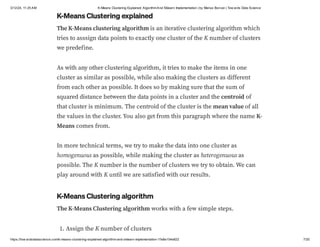


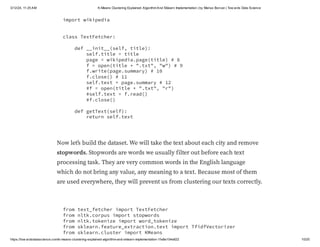
![3/12/24, 11:25 AM K-Means Clustering Explained: AlgorithmAnd Sklearn Implementation | by Marius Borcan | Tow ards Data Science
https://tow ardsdatascience.com/k-means-clustering-explained-algorithm-and-sklearn-implementation-1fe8e104e822 11/20
import nltk
def preprocessor(text):
nltk.download('stopwords')
tokens = word_tokenize(text)
return (" ").join([word for word in tokens if word not in
stopwords.words()])
if __name__ == "__main__":
textFetcher = TextFetcher("London")
text1 = preprocessor(textFetcher.getText())
textFetcher = TextFetcher("Paris")
text2 = preprocessor(textFetcher.getText())
textFetcher = TextFetcher("Berlin")
text3 = preprocessor(textFetcher.getText())
docs = [text1, text2, text3]
Word vectorization techniques
It’s a known fact that computers are tipically very bad at understanding text,
but they are perform way better at working with numbers. Because our
dataset is made out of words, we need to transform the words into numbers.
Word embeddings or word vectorization represent a collection of
techniques used to assign a word to a vector of real numbers that can be
used by Machine Learning for certain purposes, one of which is text
clustering.](https://image.slidesharecdn.com/k-meansclusteringexplainedalgorithmandsklearnimplementationbymariusborcantowardsdatascience-240313211048-f9eb87a4/85/K-Means-Clustering-Explained_-Algorithm-And-Sklearn-Implementation-_-by-Marius-Borcan-_-Towards-Data-Science-pdf-11-320.jpg)
![3/12/24, 11:25 AM K-Means Clustering Explained: AlgorithmAnd Sklearn Implementation | by Marius Borcan | Tow ards Data Science
https://tow ardsdatascience.com/k-means-clustering-explained-algorithm-and-sklearn-implementation-1fe8e104e822 12/20
The Scikit-Learn library contains a few word vectorizers, but for this article
we are going to choose the TfidfVectorizer.
tfidf_vectorizer = TfidfVectorizer()
tfidf = tfidf_vectorizer.fit_transform(docs)
Now it's time to apply our K-Means cluster algorithm. We are lucky that the
Scikit-Learn has a very good implementation of the K-Means algorithm and
we are going to use that. Because we know that we want to classify our texts
into 3 categories(one for each city) we will define the K value to be 3.
kmeans = KMeans(n_clusters=3).fit(tfidf)
print (kmeans)
# Output: [0 1 2]
I know, it’s that simple! Now what does our output mean? Simply put, those 3
values are our 3 clusters.
To test them, we can now provide 3 texts about which we know for sure they
should be in different clusters and see if they are assigned correctly. We have](https://image.slidesharecdn.com/k-meansclusteringexplainedalgorithmandsklearnimplementationbymariusborcantowardsdatascience-240313211048-f9eb87a4/85/K-Means-Clustering-Explained_-Algorithm-And-Sklearn-Implementation-_-by-Marius-Borcan-_-Towards-Data-Science-pdf-12-320.jpg)
![3/12/24, 11:25 AM K-Means Clustering Explained: AlgorithmAnd Sklearn Implementation | by Marius Borcan | Tow ards Data Science
https://tow ardsdatascience.com/k-means-clustering-explained-algorithm-and-sklearn-implementation-1fe8e104e822 13/20
to make sure we don’t forget to also vectorize these 3 texts so that our
algorithm can understand them.
test = ["This is one is about London.", "London is a beautiful
city", "I love London"]
results = kmeans.predict(tfidf_vectorizer.transform(test))
print (results)
# Prints [0, 0, 0]
test = ["This is one is about Paris.", "Paris is a beautiful
city", "I love Paris"]
results = kmeans.predict(tfidf_vectorizer.transform(test))
print (results)
# Prints [2, 2, 2]
test = ["This is one is about Berlin.", "Berlin is a beautiful
city", "I love Berlin"]
results = kmeans.predict(tfidf_vectorizer.transform(test))
print(results)
# Prints [1, 1, 1]
test = ["This is about London", "This is about Paris", "This
is about Vienna"]
results = kmeans.predict(tfidf_vectorizer.transform(test))
print (results)
# Prints [0, 2, 1]](https://image.slidesharecdn.com/k-meansclusteringexplainedalgorithmandsklearnimplementationbymariusborcantowardsdatascience-240313211048-f9eb87a4/85/K-Means-Clustering-Explained_-Algorithm-And-Sklearn-Implementation-_-by-Marius-Borcan-_-Towards-Data-Science-pdf-13-320.jpg)

